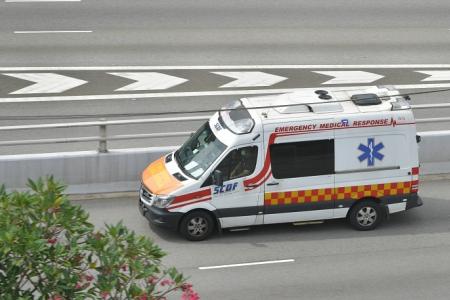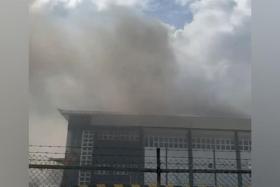New system lets SCDF ambulances reach hospital 100sec faster
Amid busy traffic one morning in September, a woman who suffered a cardiac arrest was being taken by an ambulance to Ng Teng Fong General Hospital (NTFGH) in Jurong East.
The woman in her 50s had fainted at the void deck of a Housing Board block in Jurong West Street 42.
The ambulance took six minutes to reach the hospital.
During that time, a team of Singapore Civil Defence Force (SCDF) paramedics, including Sergeant 3 (SGT3) Sharon Tan Yan An, treated the unconscious woman on board the vehicle.
Arriving at the hospital, the woman’s heart began to pump again, and she was handed over to hospital staff to be looked after.
The ambulance was able to reach the hospital faster due to a new system that gives SCDF’s emergency ambulances priority at certain traffic lights.
Speaking to the media on Nov 22 at Jurong Fire Station where she is based, SGT3 Tan, 26, said: “Every second matters for such cases, especially when it involves an organ like the heart.”
SGT3 Tan, who has been with SCDF for five years, added: “The faster we can reach (the hospital), the faster the patient can get care.”
Announced at SCDF’s Workplan Seminar in July, the traffic priority system allows ambulances to have a “green light” path to the hospital and avoid getting stuck in traffic at junctions near hospitals or having to run red lights.
The first phase of the system was implemented on July 15 and involved two ambulances operating from Jurong Fire Station and one from Bukit Batok Fire Station, and four junctions in the vicinity of NTFGH.
Data recorded in these areas over the next three months showed a total of 76 activations for life-threatening medical emergencies for the three ambulances across three routes near the hospital.
SCDF said the results indicated an average of 1min 40sec saved per trip.
The system was developed by SCDF, the Home Team Science and Technology Agency, and the Land Transport Authority.
It uses an electronic transponder in an ambulance to activate priority passage at designated traffic junctions near hospitals.
At these junctions, sensors are linked to traffic light controllers, which trigger traffic lights in favour of an approaching ambulance.
The sensors detect the in-vehicle transponder through radio waves and are activated as the ambulance approaches within 200m of the junction.
Normal traffic operations resume after the ambulance crosses the junction.
The next phase will be completed by the second quarter of 2025. It entails the installation of transponders in all other SCDF ambulances and the extension of the system’s coverage to Khoo Teck Puat Hospital, Changi General Hospital and National University Hospital.
The system is scheduled to be fully rolled out by 2026 and will involve a total of 47 junctions serving nine public hospitals.
“These time savings facilitated the earlier arrival and more timely treatment of patients at hospital emergency departments,” SCDF added.
Colonel Hong Dehan, SCDF’s chief medical officer, said the implementation of the first phase of the traffic priority system has shown encouraging results, noting that the time saved is particularly important for cases of cardiac arrest, trauma or stroke.
SGT3 Nur Ain Abdul Karim, 32, another paramedic from Jurong Fire Station, recounted an incident in July where she attended to a man who was bleeding from an old wound on his back.
The man, in his 50s, agreed to go to the hospital, but started to lose consciousness when he headed to the toilet at the unit.
He also began breathing abnormally and started having a seizure. Though he regained consciousness, he was in a confused state.
He was taken to NTFGH in six minutes via a route with the traffic priority system.
SGT3 Ain, who has been with SCDF for 6½ years, said this was a life-threatening emergency, with the paramedics unaware of how much blood the man had lost prior to their arrival.
With several unknowns, including how the injury was sustained, there was a need for the patient to be taken to the hospital as soon as possible for assessment and treatment, she said.
“The faster we take the patient to the hospital, the faster they can intervene,” she added.
Get The New Paper on your phone with the free TNP app. Download from the Apple App Store or Google Play Store now


